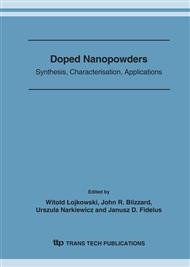[1]
S. Pauser, R. Reszka, S. Wagner, K.J. Wolf, H.J. Buhr, G. Berger: Anti-Cancer Drug Des. 12 (1997), p.125.
Google Scholar
[2]
C.H. Kiang, W.A. Goddard, R. Beyers, J.R. Salem, D.S. Bethune: J. Phys. Chem. Solids 57 (1996), p.35.
Google Scholar
[3]
J.M. Bonard, S. Seraphin, J.E. Wegrowe, J. Jiao, A. Chatelain: Chem. Phys. Lett. 343 (2001), p.251.
Google Scholar
[4]
R. Seshadri, R. Sen, G.N. Subbanna, K.R. Kannan, C.N.R. Rao: Chem. Phys. Lett. 231 (1994), p.308.
Google Scholar
[5]
X. Sun, A. Gutierrez, M.J. Yacaman, X. Dong, S. Jin: Mater. Sci. Eng. A 286 (2000), p.157.
Google Scholar
[6]
J. Jiao, S. Seraphin: J. Phys. Chem. Solids 61 (2000), p.1055.
Google Scholar
[7]
E. Flahaut, F. Agnoli, J. Solan, C. O'Connor, M.L.H. Green: Chem. Mater. 14 (2002), p.2553.
Google Scholar
[8]
Z.H. Wang, C.J. Choi, B.K. Kim, J.C. Kim, Z.D. Zhang: Carbon 41 (2003), p.1751.
Google Scholar
[9]
Z.H. Wang , Z.D. Zhang, C.J. Choi, B.K. Kim: J. Alloys and Compounds 361 (2003), p.289.
Google Scholar
[10]
B.H. Liu, J. Ding, Z.Y. Zhong, Z.L. Dong, T. White: Chem. Phys. Lett. 358 (2002), p.96.
Google Scholar
[11]
L.B. Avdeeva, D.I. Kochubey, Sh.K. Shaikhutdinov: Appl. Catal. A-Gen. 177 (1999), p.43.
Google Scholar
[12]
W. Qian, T. Liu, F. Wei, Z. Wang, Y. Li: Appl. Catal. A-Gen. 258 (2004), p.121.
Google Scholar
[13]
H.Y. Wang, E. Ruckenstein: Carbon 40 (2002), p. (1911).
Google Scholar
[14]
A. Lim, A. Shimizu, S.H. Yoon, Y. Korai, I. Mochida: Carbon 42 (2004), p.1273.
Google Scholar
[15]
Z. Zhong, H. Chen, S. Tang, J. Ding, J. Lin, K.L. Tan: Chem. Phys. Lett. 330 (2000), p.41.
Google Scholar
[16]
Z. Zhong, B. Liu, L. Sun, J. Ding, J. Lin, K.L. Tan: Chem. Phys. Lett. 362 (2002), p.135.
Google Scholar
[17]
X. Ma, Y. Cai, N. Lun, Q. Ao, S. Li, F. Li, S. Wen: Mater. Lett. 57 (2003), p.2879.
Google Scholar
[18]
H. Dai, A.G. Rinzler, P. Nikolaev, A. Thess, D.T. Colbert: Chem. Phys. Lett. 260 (1996), p.471.
Google Scholar
[19]
X. Ma, Y. Cai, X. Li, S. Wen: Mater. Sci. Eng. A 357 (2003), p.308.
Google Scholar
[20]
R.K. Rana, X.N. Xu, Y. Yeshurun, A. Gedanken: J. Phys. Chem. B 106 (2002), p.4079.
Google Scholar
[21]
Z. Lendzion-Bieluń, M. Podsiadły, U. Narkiewicz, W. Arabczyk: Rev. Adv. Mater. Sci. 12 (2006), p.145.
Google Scholar
[22]
V. Ivanom, A. Fonseca, J.B. Nagy, A. Lucas, P. Lambin, D. Bernaerts, X.B. Zhang: Carbon 33 (1995), p.1727.
Google Scholar


